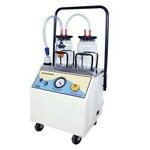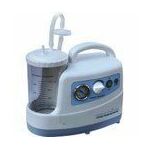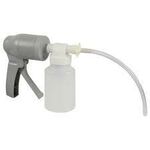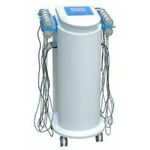Suction Machine
Description of Suction Machine:
A suction machine is a medical device that is used to remove secretions, blood, or other fluids from a patient's airway, lungs, or other areas of the body. Suction machines come in different types, sizes, and models, but they all work on the same principle: creating a vacuum or negative pressure that pulls fluids and debris out of the body. In this article, we will discuss the use of suction machines, the different types of suction machines available, their prices, and the best suction machines on the market.
Types of Suction Machine:
- Portable Suction Machines: Portable suction machines are designed for mobility and convenience. They are battery-powered and can be easily transported from one location to another, making them ideal for use in home care, ambulances, and other settings where mobility is required.
Portable suction machines come in different sizes and models, with varying suction power and features. Some portable suction machines have a rechargeable battery, while others require disposable batteries. They are typically lightweight and compact, making them easy to store and transport.
- Hand Suction Machines: Hand suction machines are manually operated and are designed for emergency use. They are lightweight and easy to use, requiring no electricity or additional equipment. Hand suction machines are often used in situations where electricity is not available, such as in the field or in remote locations.
Hand suction machines are typically small and portable, making them easy to carry in a first aid kit or medical bag. They can be used to suction fluids, secretions, and other materials from the mouth, throat, and other areas of the body.
- Foot Operated Suction Machines: Foot-operated suction machines are manually operated and are designed for use in emergency situations. They are often used in areas where electricity is not available or as a backup to electric suction machines. Foot-operated suction machines are typically larger and more powerful than hand suction machines, making them capable of removing larger volumes of fluid and debris.
Foot-operated suction machines require no electricity and can be easily transported. They are typically operated by pressing down on a foot pedal, which creates suction to remove fluid and debris from the body.
- Manual Suction Devices: Manual suction devices are hand-held devices that are used to suction fluid and debris from the body. They are typically used in emergency situations or in areas where electricity is not available. Manual suction devices come in different sizes and models, with varying suction power and features.
Manual suction devices are lightweight and easy to use, requiring no electricity or additional equipment. They can be used to suction fluids, secretions, and other materials from the mouth, throat, and other areas of the body.
Use of Suction of Devices:
- Respiratory Care: Suction machines are commonly used in respiratory care to remove excess mucus, saliva, and other secretions from the airways. This is especially important for patients with respiratory illnesses such as pneumonia, asthma, or chronic obstructive pulmonary disease (COPD). Suctioning can help patients breathe more easily and reduce the risk of respiratory complications.
- Surgical Procedures: Suction machines are often used during surgical procedures to remove blood, fluid, and other debris from the surgical field. This can help the surgeon to see the surgical site clearly and reduce the risk of infection.
- Emergency Care: Suction machines are essential in emergency care situations such as choking, drowning, or aspiration. They can quickly remove fluid and debris from the airway to prevent asphyxiation and restore breathing.
- Dental Care: Suction machines are used in dental care to remove excess saliva, water, and other debris during dental procedures. This helps to keep the mouth clear and dry, improving the dentist's visibility and reducing the risk of infection.
Benefits of Suction machine:
Suction machines offer numerous benefits to both medical professionals and patients. Here are two of the primary benefits of using suction machines:
- Efficiency: Suction machines are designed to remove fluids, secretions, and debris quickly and efficiently from the body. This improves the efficiency of medical procedures and reduces the risk of complications such as infection or choking. By removing excess fluids and debris, suction machines help to promote patient comfort and safety.
Suction machines are particularly efficient in emergency situations, where quick and effective suctioning can mean the difference between life and death. Portable suction machines, in particular, are designed to be easily transported and used in a variety of settings, making them a valuable tool for emergency medical services.
- Versatility: Suction machines are versatile medical devices that can be used in a variety of medical settings and procedures. They can be used to remove fluids and debris from the respiratory system, surgical sites, dental procedures, and other areas of the body. This makes them a valuable tool for medical professionals in a range of specialties, including respiratory therapy, surgery, dentistry, and emergency medicine.
Limitations: Power, Accessibility:
While suction machines offer many benefits in medical settings, there are also some limitations to their use. Here are two of the primary limitations of suction machines:
- Power: The power of suction machines can be a limitation, particularly in emergency situations where quick and effective suctioning is essential. Some suction machines may not be powerful enough to remove thick or heavy secretions, which can lead to complications such as choking or respiratory distress.
To overcome this limitation, medical professionals may need to use more powerful suction machines or alternative suctioning techniques to ensure that patients receive the necessary care. It is important to choose the right suction machine for the specific medical procedure or patient need to ensure that it is effective in removing the necessary fluids and debris.
- Accessibility: Another limitation of suction machines is their accessibility. In some settings, such as in remote or low-resource areas, suction machines may not be readily available or easily accessible. This can be a significant limitation in emergency situations or in cases where immediate suctioning is required.
To overcome this limitation, portable suction machines or alternative suctioning techniques may be used in these settings. However, it is important to ensure that the suction machine is appropriately maintained and serviced to ensure that it is effective and safe to use.






